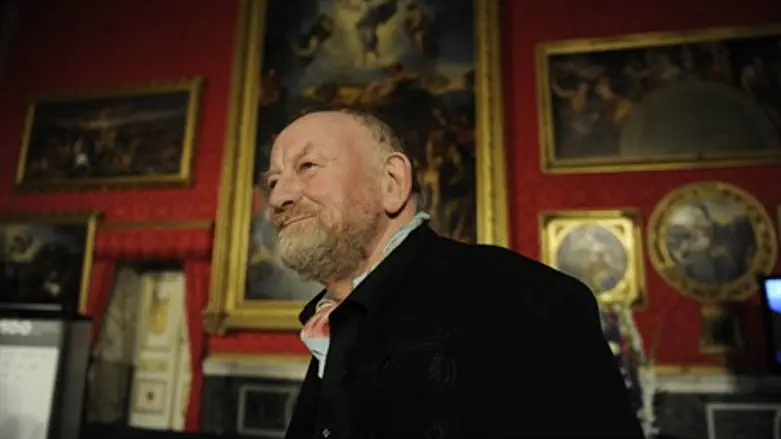
Ten years after a Danish newspaper triggered deadly protests by publishing 12 cartoons of the founder of Islam Mohammed, the man behind the most infamous drawing says he feels anger but no regret.
Kurt Westergaard, 80, has received numerous death threats and lives under police protection since his caricature of a swarthy man with a bomb swaddled in his turban was published by daily Jyllands-Posten on September 30, 2005.
In 2010 an ax and knife-wielding man broke into his home, forcing him to take refuge in a panic room for 10 minutes as his attacker pounded on the door, while his five-year-old granddaughter was left alone in the living room.
"My basic feeling has been and still is anger. If you are threatened I think anger is a good feeling because it is like you mentally strike back," he told AFP in a telephone interview.
With his brightly colored scarves, silver encrusted walking stick and a grizzled red beard, Westergaard is not a man who easily blends in, and he has had abuse shouted at him by people from Denmark's Muslim immigrant community.
"I have no problems with Muslims as a whole, I will always fight for people's right to have their religion and their beliefs. That is a private matter," said the artist, who became an atheist after growing up in a conservative Christian home.
Rather than an attack on Muslims, his illustration should be seen as a criticism of "terrorists who get their spiritual ammunition from parts of the Koran," he said.
Routine job
When Jyllands-Posten published the 12 cartoons, they triggered deadly protests around the world as demonstrators burned Danish flags and torched diplomatic offices.
The drawings were printed as part of a debate about self-censorship and freedom of expression, after no one could be found to illustrate a children's book about Mohammed amid fears that drawings of him - prohibited by Islam - would provoke retaliation.
The cartoons were once again thrust into the spotlight this year after January's deadly attack on French weekly Charlie Hebdo, which had published the Danish cartoons to show its support for press freedom.
Less than a month later, Danish-born gunman Omar El-Hussein killed a filmmaker outside a Copenhagen free speech event with Swedish artist Lars Vilks, whose 2007 sketch of the Prophet Mohammed as a dog whipped up Muslim outrage.
Hours later the gunman opened fire at a synagogue, killing a Jewish man.
Like the rest of Jyllands-Posten - which was founded in a region of wealthy, conservative farmers and is widely viewed as Denmark's most right-wing daily - Westergaard was shocked by the reactions sparked by his work.
"During the years I have made a lot of cartoons that criticize politicians and politics, so it was kind of a routine job. It was just another day at the office," he said.
A decade later, he says he has no regrets and believes that what happened was inevitable.
"Now it was the cartoons that started this confrontation or collision, but it might also have been a play, a book or something else," he said.
Westergaard retired from Jyllands-Posten in 2010, saying he hoped to lower the terror threat against the paper, which has been the target of several terror plots.
Danish terror fears
Although it has never backed down from its 2005 publication, the newspaper, citing security concerns, was the only major Danish daily not to carry any illustrations from Charlie Hebdo in the wake of the Paris attacks, in which gunmen killed 12 people.
"The truth is that for us it would be completely irresponsible to print old or new Prophet drawings right now," editor Jorn Mikkelsen wrote.
Westergaard said the decision illustrated how freedom of speech had suffered a setback amid widespread fear over another attack.
"I think the Danes today are very much afraid of terror, of these sudden attacks. And it is very difficult to admit that you are afraid," he said.
He was especially critical of the head of Denmark's trade union for school principals, who recently said that showing the Mohammed cartoons in schools was unnecessary.
"They say that now we must show tolerance and we must be very careful that we don't offend our fellow Muslim citizens. But the fact is that it is fear, and that is something very deplorable," he said.
"Of course I understand that people are afraid, I am also afraid, but I am more angry than I am afraid," he added.
Since retiring, he sells his art through a gallery in rural Denmark that has raised money for charities as well as for Charlie Hebdo.
As the 10-year anniversary of the controversial cartoons neared, he said he was "excited" to see how Danish media would commemorate them. He did not, however, think there would be any new caricatures of Mohammed as it would be too dangerous.
On a more upbeat note, he argued the setback was temporary.
"You can't suppress or prevent journalists, intellectuals and creative people from using freedom of speech," he said.